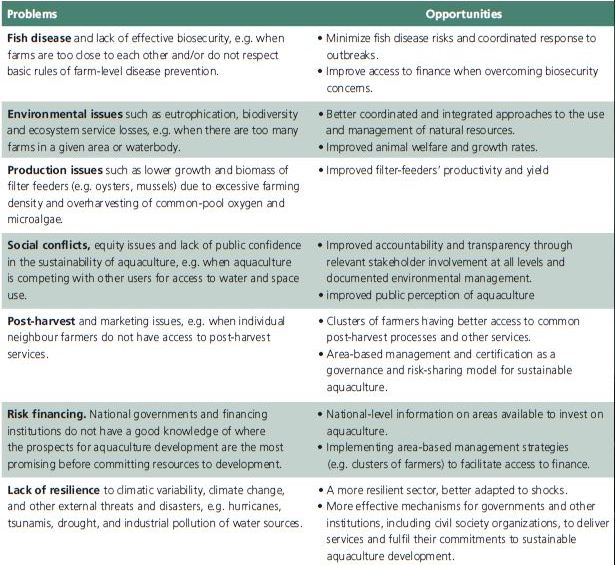1.2 Why spatial planning of aquaculture?
Inappropriate spatial arrangement and site selection of aquaculture is a major constraint to sustainable development and expansion of the industry. To create a successful aquaculture business, it is necessary to have farm sites based in locations that are suitable for sustainable production.
All aquaculture species have specific biological needs such as oxygen, temperature and good water quality that have to be fulfilled to secure high production and to minimize stress and disease. Location of aquaculture farms require access to land and water where use must also co-exist with other human activities. Access to roads and electricity (infrastructure) is also necessary. A poor location of an aquaculture farm or zone will not only create environmental problems such as localized eutrophication, it may also have a broader impact on environmental, social and economic aspects, such as conflicts with other human activities over the use of inland and coastal zone resources, that can detract from the benefits of a sustainable aquaculture industry.
Common problems arising from the lack of spatial planning and management of aquaculture can be categorized as: (i) fish disease; (ii) environmental issues; (iii) production issues; (iv) social conflict; (v) post-harvest and marketing issues; (vi) risk financing; and (vii) lack of resilience to climatic variability, climate change and other external threats and disasters. Spatial planning and management of aquaculture can be done at several geographical scales to address problems in aquaculture and provide opportunities to enhance development (Table 2).
When spatial planning is within a Blue Growth or Blue Economy Programme, there are additional opportunities to link to other initiatives such as innovative financing and energy efficiencies which can improve social, economic and ecosystem outcomes.3 Spatial planning could also be a means to improve negative public perception about potential environmental impacts, especially those associated with marine fish farming, and on access to and use of coastal resources.4,5
3 FAO. 2015. Achieving Blue Growth through implementation of the Code of Conduct for Responsible Fisheries. Policy Brief. Rome, FAO. (also available
at www.fao.org/fileadmin/user_upload/newsroom/docs/BlueGrowth_LR.pdf).
4 Bacher (2015) provides a global overview and synthesis of studies on perceptions of aquaculture in both developed and developing countries. The document also includes recommendations for policy-makers, the industry and other stakeholders on improving public understanding of aquaculture and on the roles various actors can play in this process.
5 The FAO workshop “Increasing Public Understanding and Acceptance of Aquaculture – the Role of Truth, Transparency and Transformation” was held in Vigo, Spain, in October 2015. The workshop covered a number of core topics related to the perceptions of aquaculture, including transparenc y and ethics, communication, collaboration, responsibilities and new approaches to better management of sector performance and perceptions (FAO, 2016a).
TABLE 2. Problems associated from the lack of spatial planning and opportunities through aquaculture zoning and area management
